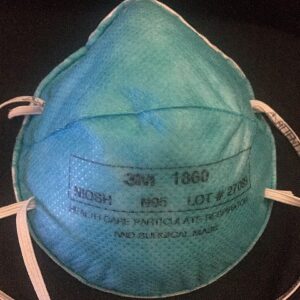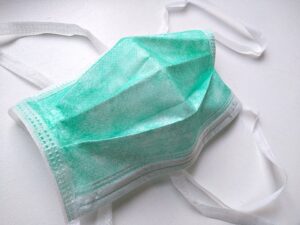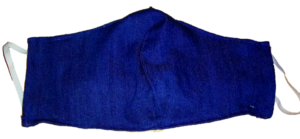Cloth Face Masks for COVID-19 Effectiveness, Best Choice, Layers, Material
Face masks have undoubtedly become one of the most popular pieces of apparel in 2020. But it is more than a matter of fashion. Face masks help prevent the spread of COVID-19 (as well as other pathogens) and is first and foremost a protective barrier. Choosing the right face mask can seem daunting at times. Research may sometimes appear contradictory at face value and fake news claiming to prove the ineffectiveness or even dangers of face masks is rife. However, the scientific evidence thus far proving the effectiveness of face masks in curbing the spread of COVID-19 is overwhelming.
Which face mask is the best?
Most of us are now far more knowledgeable about face masks than we were pre-2020 and probably far more than we may ever have needed to be in our respective professions. Broadly there are 4 types of face masks:
- N95 masks
- Surgical masks, also known as medical masks
- Cloth masks
- Valve masks
N95 masks offer the most amount of protection. Valve masks, not the N95 type, allow unfiltered air to be expelled into the environment and does not protect those around you. These masks should be avoided. Medical professionals have long understood the importance of N95 masks, especially when it comes to a pandemic. Other front-line workers may also be candidates for these types of masks.
However, N95 masks can be expensive and in short supply. These masks also cannot be cleaned easily without specialized equipment and need to be replaced often. It should therefore be reserved for medical professionals and other high risk workers. Many people who are not accustomed to the N95 mask may also find it difficult to wear these masks for long periods. For most people who are not in high risk professions, a surgical or cloth mask is usually sufficient.
Surgical masks may not be necessary if you are not a front-line worker and these single-use masks can be costly in the long run. Even gaiters, also known as face buffs or buff masks, offer some degree of protection than no mask. A recent study about the ineffectiveness of gaiters seems to be large misinterpreted. The bottom line is that some face covering is better than no face covering, and it is not just about protecting yourself. Masks prevent you from infecting others around you.
Cloth Face Masks
A cloth face mask is cheap, easily available and durable. Even if it is not a store-bought mask, these cloth masks can be made at home with various fabrics. Cloth masks can be reused but should be thoroughly washed after each use. Therefore every person should have 2 or 3 masks available. Masks should not be shared. It should be washed in hot water (at least 70°C or 140°F) with soap or bleach for at least 5 minutes. The mask should be thoroughly dried before using again.
What material is best for a cloth mask?
Medical grade polypropylene is ideal but other materials may be more practical for commercial and homemade cloth masks. Cotton is one of the recommended fabrics for cloth masks. This should be tightly woven cotton, around 600 threads per inch. Recent studies have shown that a combination of cotton and chiffon layers, or cotton and natural silk layers may be more effective than a multi-layered cotton mask.
How many layers effective for a cloth mask?
The American Center for Disease Control (CDC) and World Health Organization (WHO) have issued directives on the minimum number of layers for a cloth a mask. While it is agreed that more layers are more effective, it is also important to consider whether a person can breathe through these layers. Therefore a three layer mask is ideal but even a two layer mask may suffice.
How should the mask fit?
Cloth face masks must be large enough to adequately cover the mouth and nose with appropriate fastenings to secure a firm fit. These fastenings may be around the ear or tied at the back of the head and should not cause irritation or chaffing. The mask should be comfortable to wear for prolonged periods without needing to be regularly adjusted or removed as this can compromise the protection offered by the mask.
Tips for Maximum Mask Effectiveness
Cloth masks can be effective in curbing the spread of infectious agents but only if used appropriately. Here are some important points to consider when using any face mask.
- Always wear the face mask when exposed to others, even if there is adequate ventilation and social distancing. The mask should only be removed once you are in a protected environment like within your vehicle with the windows closed or in your home. However, home use of a cloth mask is advisable if there are high risk individuals within the homestead.
- The mask must cover both the nose and mouth adequately. Dropping a mask below the nose or under the chin reduces its effectiveness or even renders it useless. Depending on regulations in different countries, the only time that these concessions may be allowed is if a person has a medical condition.
- Wash the cloth mask after every use. Infective droplets can adhere to the masks for long periods and cause an infection hours or even days after contamination. As advised, these masks should be washed in hot water with soap or bleach for at least 5 minutes and adequately dried.
- Never share a mask. Infective droplets on the mask can infect another person who uses the mask. Each person should have their own set of at least 2 or 3 masks. Sharing should be avoided even if a mask has been washed and dried, similar to not sharing a toothbrush.
- Replace a cloth mask once it shows signs of wear and tear, especially if you have made your face mask from previously used materials like clothing. Fraying reduces the effectiveness of the mask to protect you and others around you. Repairing a cloth mask may not be effective.
- Be careful with decorations on masks. This can sometimes reduce the effectiveness of the mask if the material is compromised. If decorations are being used then ensure that inner layers are not pierced, stained or damaged in any way to reduce the effectiveness of the mask.
References:
- Homemade Cloth Face Masks. University of Utah Health
- Which type of face mask is most effective against COVID-19? Loma Linda University Health.
- What material is best for homemade masks? Medical News Today






